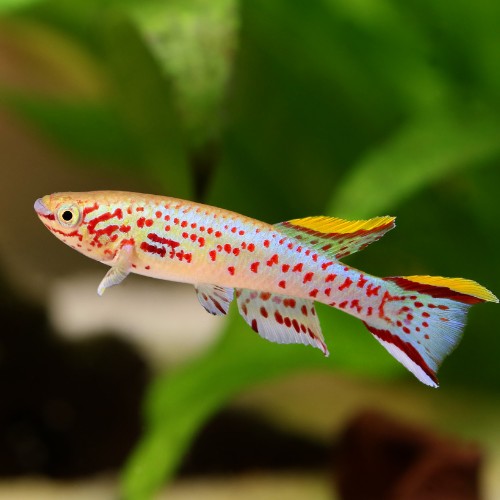
The jewels of the natural aquarium
F. MattierShare
There is a family of small freshwater fish among the most beautiful, yet little known to the public.
For they are not very happy in a traditional "living room" aquarium, with its unstable ecosystem supported by increasingly complex and expensive pumps and filters.
These "community" aquariums have a few neon tetras alongside two angelfish in a cramped space and a swarm of overlit guppies!

The killifish, as they are commonly called, do not appreciate this technology, these artificial and overly maintained decorations.
These fish, generally of modest size, are particularly colorful and not widely available in the market. They are true gems, but the pet store tank does not showcase them at all and is not suitable for them.

And this precisely because they are very attached to natural maintenance conditions.
One can therefore say that killifish, poorly suited to traditional aquaristics, are on the other hand the star fish of the natural aquarium.
No filter (or a very small corner filter), soft lighting (it's even prettier!), a tangle of plants living their life (Najas is perfect), and natural food.

"Depending on the species, you will need very soft and acidic water (a bit of rainwater and some alder tannin fruits) or water closer to that of the tap. Some species live at 20°C without heating, while others prefer more warmth."
Most swim little and therefore need a small aquarium.
Above all, and this was once the main difficulty that made them rare in trade: they absolutely want natural food, small prey like in nature.

Keeping one male and two females in 30 to 50 liters is often the norm.
Living food avoids polluting the water and does not rot when it is not eaten, and the plants are enough to consume all the nitrates of this very simple little ecosystem.
Observing them is fascinating. Instead of swimming back and forth all day long, they pose, hide, hunt a daphnia in ambush, half-bury themselves in the peat, and lay eggs continuously.

Their reproduction is original, unique, and incessant. Their eggs can generally be kept out of water, even... sent by mail!
Certain species are threatened or extinct in their natural habitat, and it is only thanks to enthusiasts that they survive.

Don't hesitate to visit the KCF website, which is the reference club in France.
But beware: if you enter this exciting world... you won't be able to leave it!
4 comments
J’ai voulu tenter le lowtech avec un couple d’aphyosemions et j’ai dû remettre un petit filtre d’angle car impossible de stabiliser mon 20l pourtant très planté… sans cesse des montées de NO2, j’ai eu peur pour les poissons… je le vis un peu comme un échec mais pas trop car au final les poissons vont très bien ce qui est le plus important ! Cet aquarium n’a plus rien de lowtech puisque j’ai aussi dû mettre un chauffage (l’eau descendait à 17° l’hiver) et que bien sûr, beaucoup de plantes = éclairage obligatoire… pour la nourriture, mes killis acceptaient bien les granulés quand ils sont arrivés de l’animalerie mais depuis que je leur donne essentiellement du vivant, maintenant ils me boudent les granulés !!
Le problème des killis, c’est leur espérance de vie. Ajouter à cela qu’on ne les trouve pas très facilement ou à des prix prohibitifs, pour peu qu’ils ne se reproduisent pas….
J’ai fait “l’expérience” d’autres poissons qui vivent très bien en low tech : les tétraodons nains ou travancoricus ! Et, pour ne rien gâcher, ils sont extrêmement intéressants à observer. Ce sont mes petits trésors.
Juste un petit souci : aucun escargot avec eux. En revanche, on peut très bien les faire cohabiter avec des crevettes et d’autres espèces d’écailleux, comme les loches naines.
Je viens également de découvrir le badis badis.
Ces trois espèces vivent en parfaite harmonie dans un 180 l super planté !
Ça me fait plaisir pour le document
Sur la nourriture vivante, cela dépend vraiment des espèces et des élevages ; mes fundulopanchax scheeli acceptent volontiers les flocons.